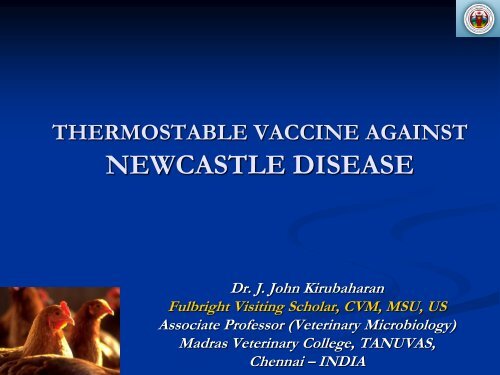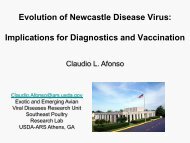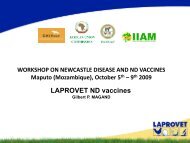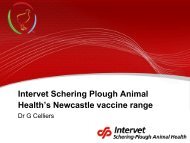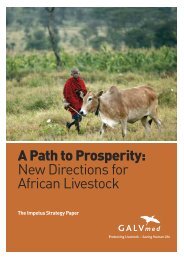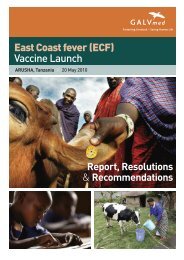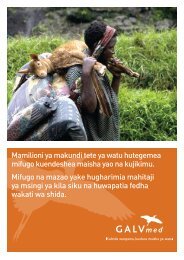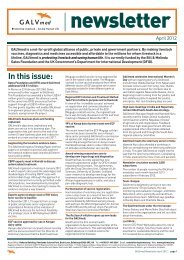NEWCASTLE DISEASE
Thermostable vaccines in India – John Kirubaharan - GALVmed
Thermostable vaccines in India – John Kirubaharan - GALVmed
- No tags were found...
Create successful ePaper yourself
Turn your PDF publications into a flip-book with our unique Google optimized e-Paper software.
THERMOSTABLE VACCINE AGAINST<br />
<strong>NEWCASTLE</strong> <strong>DISEASE</strong><br />
Dr. J. John Kirubaharan<br />
Fulbright Visiting Scholar, CVM, MSU, US<br />
Associate Professor (Veterinary Microbiology)<br />
Madras Veterinary College, TANUVAS,<br />
Chennai – INDIA
Organization of the talk<br />
• How did we develop the vaccine?<br />
• How in house validation was carried out?<br />
• How the demands of the industry was satisfied?<br />
• What are the utilities of the vaccine?<br />
• What we are doing now and where we go from here?
Stages in development<br />
• Carried out in 7 Stages<br />
• Stage 1 – Selection of a suitable strain / isolate<br />
• Stage 2 – Studies on thermostabilization<br />
• Stage 3 – Production & Standardization of the vaccine<br />
• Stage 4 – Laboratory trials - post-vaccinal responses<br />
• Stage 5 – Genetic characterization of the seed virus<br />
• Stage 6 – Field trials<br />
• Stage 7 – Technology transfer
Stage 1 – Selection of isolate<br />
• Isolation of ND from apparently normal birds,<br />
which were not vaccinated<br />
• From 160 cloacal swabs - 16 isolates<br />
• All isolates characterized<br />
• ICPI values ranged from 0.14 to 1.75<br />
• ICPI values correlated with the sequence of FPCS<br />
region<br />
• Selection criteria for identification of seed virus<br />
• Based on OIE (2000), EEC norms – with lowest ICPI<br />
• D58 – ICPI 0.14 (Lower than F and LaSota)
Stage 2 - Thermostabilization<br />
• Thermostability studies<br />
• Protocol – Aidni Idris et al, 1991<br />
• Exposure of virus to temperature ranging from 25-<br />
56 o C and passaging in eggs after every temperature<br />
treatment<br />
• Duration of temperature treatment<br />
• At 25 o C – 36 days<br />
• At 37 o C – 29 days<br />
• At 56 o C – 5 hrs<br />
• Virus presence confirmed by HA and EID 50 estimation<br />
at regular intervals<br />
• Thermostable clones were finally amplified in ECE<br />
• Virus titration - EID 50
Stage 2 – Thermostabilization<br />
HA TITRE - Log 10 values<br />
25 o C 37 o C 56 o C<br />
2.4082 3.0103 2.7093<br />
EID 50 / 0/1ML<br />
INTITIAL<br />
THERMOSTABILIZATION<br />
25 o C 37 o C 56 o C<br />
FINAL<br />
10 8.5 10 4.5 10 5.5 10 2.5 10 7.5
Stage 2 – Thermostabilization<br />
• Checking the thermostability<br />
• Checked by stability of haemagglutinin at<br />
various temperature<br />
• No variations in HA titre at 4 o C, 25 o C and 37 o C<br />
• HA activity dropped by one well at 56 o C<br />
• Was also validated by a Government vaccine<br />
manufacturing unit
Stage 3 – Production & Standardization<br />
• Virus purified by plaque purification method<br />
• Master seed virus (MSV) prepared as per OIE 2000 -<br />
titre of MSV EID 50 10 8.0 /0.1 ml<br />
• Working seed virus (WSV) produced as and when<br />
required<br />
• Vaccine production<br />
• Produced in such a manner that every dose<br />
contains EID 50 10 6.5 /0.1 ml
Stage 3 – Production & Standardization<br />
• Followed the standards specified in OIE 2000<br />
• Standardized for safety, purity and potency<br />
• Safety –<br />
• 10 doses given to unprimed birds<br />
• No harmful effects, symptoms or death<br />
• Purity – Bacterial, fungal and viral (IB)<br />
• Free from aerobic, anaerobic, fungal and negative for<br />
IB<br />
• Potency – No Challenge based potency<br />
• 1/10th of dose given to birds<br />
• Birds developed serum antibody titre of > 16 at 21 days<br />
(Group average)
Stage 4 – Post vaccination trials<br />
• Laboratory trials # 1<br />
• Unprimed and mat. Ab negative chicks - 120<br />
• Primed with D58<br />
• Sero-conversion studies<br />
• HI and ELISA<br />
• Serum collection – 0,7,14,21 PV and 7,14 PC<br />
• Four fold increase in serum antibody titre<br />
• Challenged with virulent NDV (obtained from IVPM) – 10 6<br />
EID 50<br />
• 100 % protection in vaccinated and varying mortality in<br />
control birds with exhibition of symptoms
Log<br />
HI titre<br />
Stage 5 – Post vaccination trials (Lab)<br />
Immune response in unprimed mat.Ab negative chicks<br />
3<br />
2.5<br />
2<br />
1.9115<br />
2.3995<br />
1.5<br />
1<br />
1<br />
0.5<br />
0<br />
0 7 21<br />
Days post vaccination<br />
Mean HI titre
Stage 5 – Post vaccination trials (Lab)<br />
• Laboratory Trial # 2<br />
• Vaccination of chickens with thermostable D58 vaccine<br />
• Assessment of CMI by under agarose leucocyte<br />
migration inhibition assay and colorimetric<br />
blastogenesis assay (in the absence of humoral<br />
response).<br />
• Assessment of mucosal immune responses by HI and<br />
IgA ELISA.<br />
• Assessment of humoral immune responses by HI and<br />
IgG ELISA.<br />
• Challenge of experimental and control chickens with<br />
virulent virus.
Stage 5 – Post vaccination trials (Lab)<br />
Laboratory Trial # 2<br />
• Laboratory trial 2<br />
• Scope – To assess mucosal, CMI and humoral responses<br />
• Vaccination by intra ocular and intranasal route<br />
• Number of birds : 36<br />
• Unvaccinated control : 18<br />
• B cell ablated and vaccinated : 9<br />
• B cell non-ablated and vaccinated : 9<br />
‣ Slaughter days : 7, 14, 21<br />
‣ Samples collected<br />
‣ Harderian gland, lachrymal fluid, tracheal swab, intestinal<br />
wash, bile, spleen and serum<br />
‣ Challenge : 28 th day
Numerous lymphoid<br />
follicles
Stage 5 – Post vaccination trials (Lab)<br />
Laboratory Trial # 2<br />
‣ Colorimetric blastogenesis assay (CBA)<br />
• The Stimulation index (SI) values started to increase from 7 th<br />
day post vaccination in both ablated and non ablated groups<br />
• No SI values could be recorded in unvaccinated controls<br />
• Statistically significant difference was observed between SI<br />
values on days 0 and 7 indicating the setting of CMI response<br />
after vaccination<br />
‣ Under agarose leucocyte migration inhibition technique (LMIT)<br />
• The pattern of percentage migration inhibition values were in<br />
similar pattern as CBA
Proliferation Index<br />
Percentage Migration inhibition<br />
Stage 5 – Post vaccination trials (Lab)<br />
Laboratory Trial # 2<br />
Cell Mediated Immune Response - CBA - LNDV<br />
0.35<br />
0.3<br />
0.25<br />
0.2<br />
0.15<br />
0.1<br />
0.05<br />
0<br />
-0.05<br />
-0.1<br />
0 7 14 21<br />
Days Post-Vaccination<br />
Ablated-Vaccinated<br />
Non-ablated-Vaccinated<br />
Ablated_Not Vaccinated<br />
Non-ablated-Not vaccinated<br />
Cell Mediated Immune Response - LMI - LNDV<br />
30<br />
25<br />
20<br />
15<br />
10<br />
5<br />
0<br />
0 7 14 21<br />
Days Post-vaccination<br />
Ablated - Vaccinated<br />
Non-ablated - Vaccinated<br />
Ablated - Not vaccinated<br />
Non-ablated - Not vaccinated
Stage 5 – Post vaccination trials (Lab)<br />
Laboratory Trial # 2<br />
‣ Mucosal immune response - IgA ELISA<br />
• Statistically significant difference was observed in OD<br />
values between vaccinated (both ablated and non ablated<br />
groups) and unvaccinated control birds on day 21<br />
• Indicates the mucosal immune response in vaccinated<br />
group<br />
‣ Humoral immune response<br />
‣ IgG ELISA and HI test<br />
• Statistically significant difference observed in OD values<br />
between vaccinated and unvaccinated birds and also<br />
between ablated and non ablated birds of vaccinated groups<br />
indicates the presence of humoral immune response in<br />
vaccinated group
Mean OD Values<br />
Mean OD Values<br />
Stage 5 – Post vaccination trials (Lab)<br />
Laboratory Trial # 2<br />
Mucosal Immune Response - IgA OD values - LNDV<br />
(ABLATED & VACCINATED)<br />
0.300<br />
0.250<br />
0.200<br />
0.150<br />
0.100<br />
0.050<br />
0.000<br />
7 14 21<br />
Days Post Vaccination<br />
Hardarien Lachrymal Trachea Intestine Bile Serum<br />
Mucosal Immune Response - IgA OD values - LNDV<br />
(NON-ABLATED & VACCINATED)<br />
0.300<br />
0.250<br />
0.200<br />
0.150<br />
0.100<br />
0.050<br />
0.000<br />
7 14 21<br />
Days Post Vaccination<br />
Hardarien Lachrymal Trachea Intestine Bile Serum
Mean OD Values<br />
Stage 5 – Post vaccination trials (Lab)<br />
Laboratory Trial # 2<br />
Mean OD Values<br />
Mucosal Immune Response - IgA OD values - LNDV<br />
(ABLATED & NOT-VACCINATED)<br />
0.300<br />
0.250<br />
0.200<br />
0.150<br />
0.100<br />
0.050<br />
0.000<br />
7 14 21<br />
Days Post Vaccination<br />
Hardarien Lachrymal Trachea Intestine Bile Serum<br />
Mucosal Immune Response - IgA OD values - LNDV<br />
(NON-ABLATED & NOT VACCINATED)<br />
0.300<br />
0.250<br />
0.200<br />
0.150<br />
0.100<br />
0.050<br />
0.000<br />
7 14 21<br />
Days Post Vaccination<br />
Hardarien Lachrymal Trachea Intestine Bile Serum
Stage 5 – Genomic characterization<br />
• Gene sequences of D58 strain available at GenBank<br />
• All the six genes (both CDS and UTR) have been sequenced<br />
• NP gene<br />
• DQ839549; EF442116<br />
• P gene<br />
• EU419882<br />
• M gene<br />
• GQ 184565<br />
• F gene<br />
• EU330230<br />
• HN gene<br />
• EU305607<br />
• L gene<br />
• GQ 2220701
Stage 5 – Genetic characterization of vaccine seed -<br />
Phylogenetic tree (NP gene)
Stage 5 – Genetic characterization of vaccine seed -<br />
Phylogenetic tree (P gene)
Stage 5 – Genetic characterization of vaccine seed -<br />
Phylogenetic tree (M gene)<br />
79<br />
98<br />
55<br />
99<br />
D58<br />
Lasota<br />
JL1<br />
Clone 30<br />
B1<br />
B1 - Takaaki<br />
100 95<br />
VG-GA<br />
63<br />
96<br />
66<br />
Roakin<br />
BeaudetteC<br />
Texas-GB<br />
DE-R49<br />
99<br />
100<br />
PHY-LMV42<br />
100<br />
NDV-08-04<br />
53<br />
PHY-LM1<br />
V4HB92<br />
89<br />
90<br />
89<br />
100<br />
I2<br />
I2 progenitor<br />
96<br />
ULSTER67<br />
Mukteswar<br />
90<br />
83<br />
99<br />
Australian V4<br />
Herts 33<br />
Italien<br />
Anhinga<br />
90<br />
99<br />
ZJ1<br />
NA1<br />
Sterna<br />
Malay sian<br />
0.01
Stage 5 – Genetic characterization of vaccine seed -<br />
Phylogenetic tree (F gene)<br />
LaSota<br />
JL-1<br />
HB92 isolate V4<br />
D58<br />
clone 30.<br />
B1 Takaaki<br />
B1<br />
ITA/45<br />
Beaudette C<br />
AQI-ND026<br />
Tex/48<br />
chicken/USA/Roakin<br />
Que/66<br />
D26/76<br />
I-2<br />
I-2progenitor<br />
Ulster/67<br />
F48E9<br />
Muktesw ar<br />
Texas)<br />
Herts/33<br />
PHY-LMV42<br />
Italien<br />
0.01
Stage 5 – Genetic characterization of vaccine seed -<br />
Phylogenetic tree (HN gene)<br />
LaSota<br />
Clone 30<br />
JL-1<br />
HB92-V4<br />
D58<br />
B1<br />
B1 Takaaki<br />
Beaudette C<br />
Tex/48<br />
AQI-ND026<br />
Roakin<br />
Texas<br />
ITA/45<br />
Italien<br />
HERTS/33<br />
Muktesw ar<br />
F48E9<br />
ULSTER/67<br />
PHY-LMV42<br />
D26.76<br />
QUE/66<br />
I-2<br />
I-2 PROGENITOR<br />
0.01
Stage 5 – Genetic characterization of vaccine seed -<br />
Phylogenetic tree (L gene)<br />
99<br />
81<br />
100<br />
B1<br />
D58<br />
Lasota<br />
Lentogenic<br />
96<br />
55<br />
B1 TAKAII<br />
Beaudette C<br />
Lentogenic<br />
Velogenic<br />
VG-GA<br />
Others<br />
100<br />
100<br />
88<br />
CLONE30 Lentogenic<br />
KBNP Others<br />
JL1 PPM<br />
83<br />
TEXAS GB<br />
Velogenic<br />
61<br />
100<br />
PHY-LMV42<br />
PHY-LM1<br />
Others<br />
87<br />
ULSTER67<br />
HB92-V4<br />
Apathogenic<br />
80<br />
100<br />
I2<br />
I2 PROGENITOR<br />
Apathogenic<br />
100<br />
ANHINGA Mesogenic<br />
STERNA Velogenic<br />
75<br />
96<br />
100<br />
ZJ1<br />
NA1<br />
Others<br />
46<br />
100<br />
Herts33<br />
Italien<br />
Velogenic<br />
53<br />
40<br />
MUKTESWAR Mesogenic<br />
F48E9 Others<br />
AUSTRALIAN VICTORIANApathogenic<br />
100<br />
DE-R49<br />
NDV08-CHINA<br />
Others<br />
0.01
Stage 6 – Field trials<br />
• Use of vaccine seed D58 as priming vaccine for broilers instead of F<br />
strain<br />
• 8500 doses<br />
• Vaccine given through nostrils<br />
• 10 th day primed with D58<br />
• 21 st day serology<br />
• HI titre - 2 4 to 2 7<br />
• ELISA titre – More than log 2.7<br />
• Titre maintained till date of lift 45 th day of age (35 days after<br />
vaccination)<br />
• One dose provided sufficient immunity
Log<br />
Titre<br />
Stage 6 – Field trials<br />
3.5<br />
3<br />
3.0066<br />
2.5<br />
2<br />
1.9605<br />
1.5<br />
1<br />
0.5<br />
0<br />
1 1<br />
0 7 21<br />
Days<br />
1.4<br />
Vaccinated<br />
Control
Trial 1<br />
Stage 6 – Field trials (Industry)<br />
• ND D 58 vaccine field trial at Udumalpet<br />
• Farm A<br />
Sl. No. Age T1-Trial T2-Control<br />
1 Day-old H 120 Spray/Ocular H 120 Spray/ocular<br />
2 Day 5 ND D 58 Ocular F Strain or B1 ocular<br />
3 Day 12 Gumboro Ocular drop Gumboro ocular drop<br />
4 Day 21 ND D 58 Ocular Lasota ocular
Trial 1<br />
Stage 6 – Field trials (Industry)<br />
• ND D 58 vaccine field trial at Udumalpet<br />
• Farm B<br />
Sl. No. Age T1-Trial T2-Control<br />
1 Day-old H 120 Spray/Ocular H 120 Spray/ocular<br />
2 Day 5 ND D 58 Ocular F Strain or B1 ocular<br />
3 Day 12 Gumboro Ocular drop Gumboro ocular drop<br />
4 Day 21 Lasota Ocular Lasota ocular
Trial 1<br />
Stage 6 – Field trials (Industry)<br />
Performance index Farm A<br />
Particulars Trial Control Difference<br />
No. Of Chicks Placed 2750 2750<br />
Mean Age of lifting (Days) 44.92 45.27 -0.35<br />
Average Daily weight gain (gms). 43.28 43.43 -0.15<br />
Average weight(Kg) 1.944 1.966 -0.022<br />
Mortality% 5.75 5.27 +0.48<br />
FCR 2.207 2.217 -0.01<br />
Medication Cost/Kg 1.16 0.53 +0.63<br />
Production Cost/Kg 34.47 33.85 +0.62<br />
European Economic Factor(EEF) 185 186 -1
Trial 1<br />
Stage 6 – Field trials (Industry)<br />
Performance index Farm B<br />
Particulars Trial Control Difference<br />
No. Of Chicks Placed 3548 3547<br />
Mean Age of lifting (Days) 45.35 46.13 -0.78<br />
Average Daily weight gain (gms). 41.59 40.54 +1.05<br />
Average weight(Kg) 1.886 1.87 +0.016<br />
Mortality% 12.63 12.49 +0.14<br />
FCR 2.217 2.288 -0.071<br />
Medication Cost/Kg 1.38 0.675 +0.705<br />
Production Cost/Kg 35.57 35.77 -0.2<br />
European Economic Factor(EEF) 164 155 +9
Trial 1<br />
Stage 6 – Field trials (Industry)<br />
Seroconversion
Trial-II<br />
Stage 6 – Field trials (Industry)<br />
Age Group1 Group2 Group3 Route<br />
Farm A<br />
Day 1 IB H120 IB H120 IB H120<br />
Hatchery<br />
Spray<br />
Day 5 ND D58 ND D58 Live B1 Eye drop<br />
Day 13 IBD IBD IBD Eye drop<br />
Day 21 ND D58 LaSota LaSota Eye drop<br />
Farm B<br />
Day 5 ND D58 ND D58 Live B1 Eye drop<br />
Day 13 IBD IBD IBD Eye drop<br />
Day 21 ND D58 LaSota LaSota Eye drop
Trial-II<br />
Farm A<br />
Stage 6 – Field trials (Industry)<br />
Chicks<br />
housed 3600 3720 13560<br />
Mean age 43.01 43.01 43.01<br />
Day gain 48.67 45.01 47<br />
Avg wt 2.10 1.910 2.029<br />
Mort% 5.46 4.56 6.17<br />
FCR 2.000 2.060 2.190<br />
Med cost 0.51 0.52 0.54<br />
Podn cost 30.87 31.94 33.5<br />
EEF 230 204 202
Trial-II<br />
Farm B<br />
Stage 6 – Field trials (Industry)<br />
Chicks<br />
housed 2100 2460 2405<br />
Mean age 43.09 43.09 43.09<br />
Day gain 50 48 49<br />
Avg wt 2.210 2.078 2.042<br />
Mort% 6.47 6.2 7.81<br />
FCR 2.000 2.020 2.122<br />
Med cost 0.5 0.5 0.51<br />
Podn cost 30.56 32.61 31.18<br />
EEF 239 205 223
Stage 7 – Transfer of Technology<br />
• Sustained effort of the University and increasing the quantity of<br />
data on D58 strain<br />
• Interest evinced by Globion of Suguna Group<br />
• Controlled field trials with 50000 doses<br />
• The sero-conversion of TANUVAS vaccine was in<br />
acceptable range.<br />
• There is no respiratory complication in birds vaccinated<br />
with TANUVAS vacccine<br />
• TANUVAS vaccine does not affect the performance<br />
parameters of broilers<br />
• Production cost may be curtailed on large scale<br />
production<br />
• Transfer on non-exclusive basis has been carried out
Immunity to turkeys<br />
• Incidence of ND in turkeys<br />
• Present use of F and LaSota vaccines<br />
• Experimental trial design<br />
• Three groups of day old 36 Beltsvile small white turkeys<br />
• Groups – 1:<br />
• 12 birds receive F vaccine on day 10 as eye/nasal drops and LaSota in water<br />
as booster on day 42;<br />
• 12 birds received F vaccine alone on day 10 as eye/nasal drops<br />
• 12 birds remain as unvaccinated controls<br />
• Group – 2: Same design as Group 1 except that instead of F vaccine as<br />
nasal/eye drop LaSota or thermostable D58 strains were used<br />
• Humoral immune response – studied by HI and ELISA from serum<br />
sample collected at weekly intervals
Log 10 titre<br />
Immunity to turkeys<br />
RDVF Vs D58 Vs LaSOTA - ELISA<br />
7.000<br />
6.000<br />
5.000<br />
4.000<br />
3.000<br />
2.000<br />
1.000<br />
0.000<br />
1 2 3 4 5 6 7 8 9 10 11 12<br />
Age in w eeks<br />
RDVF+LaSOTA D58+LaSOTA LaSota+LaSota
Log 10 titre<br />
Immunity to turkeys<br />
RDVF Vs D58 Vs LaSOTA - HI<br />
2.500<br />
2.000<br />
1.500<br />
1.000<br />
0.500<br />
0.000<br />
-0.500<br />
1 2 3 4 5 6 7 8 9 10 11 12<br />
Age in w eeks<br />
RDVF+LaSOTA D58+LaSOTA LaSota+LaSota
Log 10 Titre<br />
Immunity to turkeys<br />
6.600<br />
6.400<br />
6.200<br />
6.000<br />
5.800<br />
5.600<br />
5.400<br />
5.200<br />
5.000<br />
4.800<br />
4.600<br />
4.400<br />
4.200<br />
4.000<br />
3.800<br />
3.600<br />
3.400<br />
3.200<br />
3.000<br />
2.800<br />
2.600<br />
2.400<br />
2.200<br />
2.000<br />
1.800<br />
1.600<br />
1.400<br />
1.200<br />
1.000<br />
0.800<br />
0.600<br />
0.400<br />
0.200<br />
0.000<br />
-0.200<br />
-0.400<br />
1 2 3 4 5 6 7 8 9 10 11 12<br />
Age in w eeks<br />
D58+La D58 No Vacc D58+La D58 No. Vacc
Development of Vaccine<br />
• Vaccine production<br />
• Lactose pellet technology<br />
• Lactose 33%, Starch 33%, Virus 34% and<br />
Amaranthus (food grade) dye<br />
• Air dried and stored in containers<br />
• Approximately 5mm<br />
• EID50 of one grain - 10 6.5<br />
• Dosage<br />
• 2 grains per bird
Standardization of Vaccine<br />
• Followed the standards specified for live ND vaccine –<br />
OIE 2000<br />
• Standardized - safety, purity and potency<br />
• Safety –<br />
• 20 grains given to unprimed birds<br />
• No harmful effects, symptoms or death<br />
• Purity – Bacterial, fungal and viral (IB)<br />
• Free from aerobic, anaerobic, fungal and negative for IB<br />
• Potency – Challenge based potency<br />
• Single grain given to birds<br />
• Birds developed serum antibody titre of > 16 at 21 days
Post vaccination trials (Lab)<br />
• Three types of trials conducted<br />
• Unprimed and mat. Ab negative chicks<br />
• Primed with D58 and Oral vaccine given as booster<br />
• Primed at hatchery + oral vaccine given instead of K<br />
• Sero-conversion studies<br />
• HI and ELISA<br />
• Serum collection – 0,7,14,21 PV and 7,14 PC<br />
• Four fold increase in serum antibody titre<br />
• Challenged with virulent NDV (obtained from IVPM) – 10 6<br />
EID 50<br />
• 100 % protection in vaccinated and varying mortality in control<br />
birds with exhibition of symptoms
Log<br />
titre<br />
Log2<br />
Titre<br />
LOG<br />
titre<br />
Stage 5 – Post vaccination trials (Lab)<br />
Immune response in unprimed mat.Ab negative chicks<br />
3<br />
2.5<br />
2<br />
1.5<br />
1<br />
0.5<br />
0<br />
2.3995<br />
1.9115<br />
1<br />
0 7 21<br />
Days post vaccination<br />
3<br />
2.5<br />
2<br />
2<br />
Oral pellet vaccine instead of K<br />
2.4136<br />
2.7180<br />
2.3780<br />
Mean HI titre<br />
1.5<br />
1<br />
3.5<br />
3<br />
2.5<br />
2<br />
D58 as primiving vaccine and oral pellet vaccine as<br />
booster<br />
3.0066<br />
2.3372<br />
2.8028<br />
0.5<br />
0<br />
0 7 21 35<br />
Days post vaccination - 0, 7, 21, 35<br />
1.5<br />
1<br />
1<br />
0.5<br />
0<br />
0 21 28 42<br />
Days
Vaccine consumption pattern<br />
• Proventriculus<br />
• Lymphoid cell aggregation – 2 nd day<br />
• Mononuclear infiltration – 4 th day<br />
• Diffused lymphoid aggregation – 5 th day<br />
• Spleen<br />
• Increase in germinal centres – 2 nd day<br />
• Trachea<br />
• Mild hypertrophy – 6 th day<br />
• Lungs<br />
• Mild congestion with lymphoid aggregation – 2 nd day<br />
• Ileocaecal junction<br />
• Mild lymphoid depletion – 6 th day
Post vaccination trials (field)<br />
• Controlled field trials<br />
• Desi birds<br />
• Erode Dt, Namakkal Dt, Kancheepuram Dt<br />
• >3000 doses<br />
• Unvaccinated birds varying serum antibody titres were<br />
observed<br />
• Four fold increase in titre<br />
• So far<br />
• No reports of untoward post-vaccinal reaction<br />
• Still supplying
Other work carried out<br />
• Phylogenetic analysis of D58 using all the six genes<br />
• Cloned and expressed NP, P, HN and F genes of D58 isolate of NDV<br />
• Antibody profile against individual proteins of NDV under different<br />
conditions<br />
• Single serum dilution ELISA to predict antibody titre in the serum of<br />
birds vaccinated against NDV<br />
• Utility of the D58 vaccine in Japanese quails<br />
• Isolation of NDV from water birds
Summary<br />
• Developed a theromostabilized live Newcastle disease vaccine<br />
• The vaccine was found to be safe, pure and potent in lab and<br />
controlled field trials<br />
• The vaccine seed was also tested under field conditions<br />
• priming vaccine in broilers gave satisfying immunity<br />
without affecting production parameters<br />
• produce satisfactory immunity in turkeys<br />
• Molecular characterization studies also proved the low<br />
pathogenicity of seed correlating with ICPI value
Log10 titres<br />
11<br />
13<br />
15<br />
17<br />
19<br />
21<br />
23<br />
25<br />
27<br />
29<br />
31<br />
33<br />
35<br />
37<br />
39<br />
41<br />
43<br />
45<br />
47<br />
49<br />
51<br />
53<br />
55<br />
57<br />
59<br />
61<br />
63<br />
65<br />
67<br />
69<br />
14.000<br />
12.000<br />
10.000<br />
8.000<br />
6.000<br />
4.000<br />
2.000<br />
0.000<br />
-2.000<br />
1<br />
3<br />
5<br />
7<br />
9<br />
Sample #<br />
WVP HN NP P F HI
Acknowledgements<br />
• To the Tamil Nadu Veterinary & Animal Sciences University and the<br />
Indian Council of Agricultural Research<br />
• To the coworkers<br />
• Ramani Pushpa, Ananth, Varalakshmi, Logeswari, Ponnusamy, Vivitha and<br />
Sadhwi Sharma<br />
• Prabhakar, Indra, Latha


